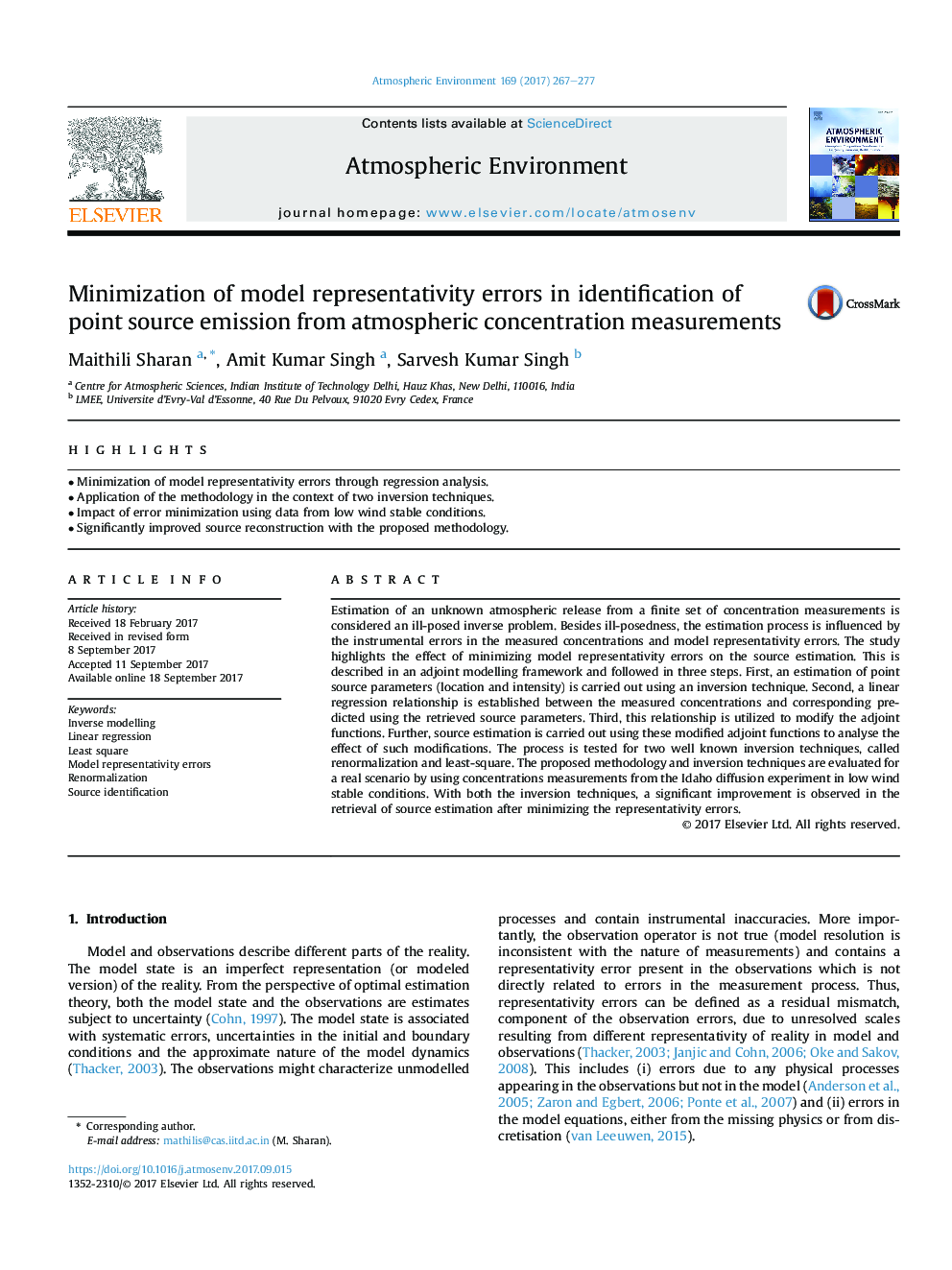| کد مقاله | کد نشریه | سال انتشار | مقاله انگلیسی | نسخه تمام متن |
|---|---|---|---|---|
| 5752820 | 1620305 | 2017 | 11 صفحه PDF | دانلود رایگان |
عنوان انگلیسی مقاله ISI
Minimization of model representativity errors in identification of point source emission from atmospheric concentration measurements
ترجمه فارسی عنوان
کمینه سازی خطاهای نمایندگی مدل در شناسایی انتشار منبع نقطه از اندازه گیری های جوی اتم
دانلود مقاله + سفارش ترجمه
دانلود مقاله ISI انگلیسی
رایگان برای ایرانیان
کلمات کلیدی
ترجمه چکیده
برآورد انتشار ناشناخته اتمسفر از یک مجموعه محدود از اندازه گیری غلظت، یک مشکل معکوس معکوس محسوب می شود. علاوه بر بدبینی، روند برآورد تحت تأثیر خطاهای ابزار در غلظت های اندازه گیری شده و خطاهای نمایشی مدل قرار می گیرد. این مطالعه تاثیر تاخیر در خطاهای نمایشی مدل را در برآورد منبع می داند. این در چارچوب مدل سازی وابسته و در سه مرحله شرح داده شده است. اولا برآورد پارامترهای منبع نقطه (موقعیت و شدت) با استفاده از تکنیک انحراف انجام می شود. دوم، رابطه ی رگرسیون خطی بین غلظت های اندازه گیری شده و پیش بینی های مرتبط با استفاده از پارامتر های منبع بازیابی ایجاد شده است. سوم، این رابطه برای تغییر توابع مجاورت استفاده می شود. علاوه بر این، برآورد منبع با استفاده از این توابع اصلاح شده همسو شده برای تحلیل اثر چنین تغییراتی انجام می شود. این فرآیند برای دو تکنیک معکوس شناخته شده شناخته می شود که نام آن تغییر شکل و حداقل مربع است. روش های پیشنهادی و تکنیک های معکوس برای یک سناریوی واقعی با استفاده از اندازه گیری های غلظت از آزمایشی انتشار آیداهو در شرایط پایدار پایدار ارزیابی می شود. با هر دو تکنیک انحراف، بهبود قابل توجهی در بازیابی برآورد منبع پس از به حداقل رساندن خطاهای نمایندگی وجود دارد.
موضوعات مرتبط
مهندسی و علوم پایه
علوم زمین و سیارات
علم هواشناسی
چکیده انگلیسی
Estimation of an unknown atmospheric release from a finite set of concentration measurements is considered an ill-posed inverse problem. Besides ill-posedness, the estimation process is influenced by the instrumental errors in the measured concentrations and model representativity errors. The study highlights the effect of minimizing model representativity errors on the source estimation. This is described in an adjoint modelling framework and followed in three steps. First, an estimation of point source parameters (location and intensity) is carried out using an inversion technique. Second, a linear regression relationship is established between the measured concentrations and corresponding predicted using the retrieved source parameters. Third, this relationship is utilized to modify the adjoint functions. Further, source estimation is carried out using these modified adjoint functions to analyse the effect of such modifications. The process is tested for two well known inversion techniques, called renormalization and least-square. The proposed methodology and inversion techniques are evaluated for a real scenario by using concentrations measurements from the Idaho diffusion experiment in low wind stable conditions. With both the inversion techniques, a significant improvement is observed in the retrieval of source estimation after minimizing the representativity errors.
ناشر
Database: Elsevier - ScienceDirect (ساینس دایرکت)
Journal: Atmospheric Environment - Volume 169, November 2017, Pages 267-277
Journal: Atmospheric Environment - Volume 169, November 2017, Pages 267-277
نویسندگان
Maithili Sharan, Amit Kumar Singh, Sarvesh Kumar Singh,
